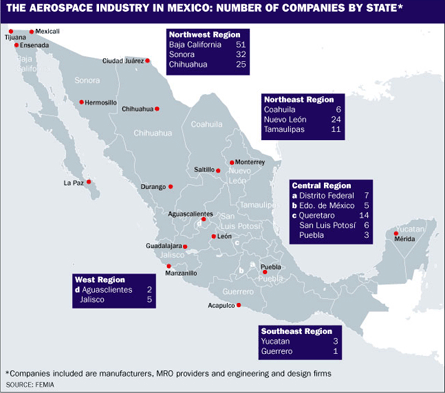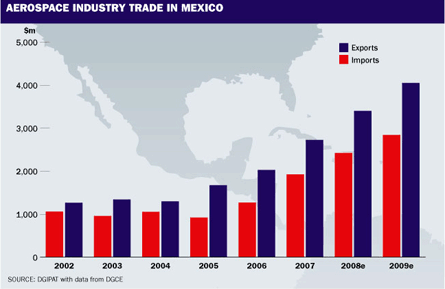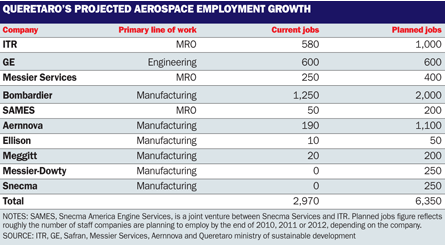Mexico's budding aerospace industry, which has tripled in size since 2004, is confident of more rapid growth as European and North American manufacturers increase their reliance on the country's factories despite the economic downturn.
Mexico has had a base of small aerospace manufacturers for decades, but it is only in the past five years that its industry has entered the global stage. The decision by several major international players - including Bombardier, Cessna, Goodrich, Honeywell and Safran - to open large plants in Mexico has firmly put the country on the global aerospace map and sent its aerospace exports soaring. Mexico is expected to export more than $4 billion worth of aerospace products this year - up from $2.7 billion in 2007 and only $1.3 billion in 2004.
"Over the last seven years there's been a real spurt in aerospace in Mexico, with growth averaging 20% a year," says Mexican Aerospace Industry Federation (FEMIA) general director Carlos Bello.
But Mexico is still a relatively unknown aerospace producer globally and even locally, says Bello. "Many people in Mexico don't even know we have an aerospace industry."
|
|---|
There are now almost 200 aerospace companies in Mexico, employing more than 27,000 workers, he says. Although only 15 of the companies have more than 500 employees, and 40 firms account for more than 90% of the exports, the number of large aerospace companies in Mexico is expected to grow sharply as major international players unveil new plants and recently opened factories get up to speed.
Queretaro, which has rapidly built its aerospace cluster after attracting Bombardier in 2005, is Mexico's best-known aerospace centre. But 14 other states in the country host aerospace companies, including 11 with manufacturing facilities (see map). Four of these states - Baja California, Chihuahua, Nuevo Leon and Sonora - have larger aerospace clusters than Queretaro's.
Baja California has Mexico's largest aerospace industry in terms of employers, with more than 50 companies including 48 manufacturers. Most of these are smaller firms based in the border towns of Tijuana or Mexicali, but there are also a couple of big aerospace players - Goodrich and Honeywell.
Three other states in northern Mexico - Chihuahua, Nuevo Leon and Sonora - each have at least 24 aerospace companies. Chihuahua has large factories operated by Cessna, Hawker Beechcraft and Safran subsidiary Labinal, and a factory that will produce Bell Helicopter parts is under construction. Bello says Labinal's Chihuahua operation, which is spread across two factories and manufactures harnesses, is the largest aerospace employer in Mexico with more than 2,000 staff.
In Sonora, there are rapidly growing aerospace clusters in the border town of Nogales, including a new factory by France's Daher which is expected to employ 1,000 people by 2012, and further south in Guaymas. The cluster at Nuevo Leon's capital, Monterrey, consists of 13 mainly small manufacturing companies, but includes a plant producing fuselages for MD Helicopters. It also has the country's largest concentration of maintenance providers and engineering firms - seven and four, respectively. By comparison, the clusters in Chihuahua and Sonora are all manufacturers.
 |
|---|
After Queretaro and Tamaulipas, which each have about 12 aerospace companies, there are eight states - from Yucatan in the far south-east to Jalisco in the west - with eight or fewer aerospace companies. Several of the 17 Mexican states that have no aerospace companies are also eager to get a piece of the action and are trying to woo foreign firms. For example, Zacatecas in central Mexico plans to open an aerospace park next year, with US supplier Triumph Group as the first tenant. Another central Mexican state, Guanajuato, is also trying to attract its first aerospace company.
US PROXIMITY
Northern Mexico has traditionally had the largest concentrations of aerospace activity because of its proximity to the USA. Northern Mexico is closer to several US aerospace centres than most parts of the USA itself. Wichita, in particular, has become a major destination for aircraft parts produced in Mexico.
Several business jet models that are assembled in Wichita by Bombardier, Cessna and Hawker Beechcraft now have large Mexican contents. Queretaro, which has three Bombardier factories and a fourth under construction, is in central rather than northern Mexico, but has better infrastructure and highway access than many cities closer to the US border. It is only about 15h by truck from Texas.
Mexican-made aircraft parts are also trucked regularly to Canada and shipped across the Atlantic to Europe, but the USA is by far the biggest market for Mexican aerospace companies. According to FEMIA, the USA accounts for about half of Mexico's aerospace exports and the country is now the 10th biggest supplier of aircraft components in the US market.
EUROPEAN SUPPLIERS
These figures include US manufacturers that have set up shops in Mexico, as well as European tier one suppliers that have opened shops in Mexico to serve their US customers better. Several European suppliers, including Daher and Spain's Aernnova, which historically have not done much work for US manufacturers, have also decided to open facilities in Mexico to improve their chances of winning work from US OEMs.
 |
|---|
Emilio Otero, FEMIA president and chief executive of Mexican engine maintenance company ITR, says the expansion of European companies has been a key driver of Mexico's aerospace growth this decade. As the strengthening euro prompted several European suppliers to look at moving some production to the dollar zone, several realised Mexico was a better option than the USA because it was cheaper but still close to US OEMs.
"Europe started to see Mexico as a good place because of the exchange rate," says Otero. "At the same time, US companies started feeling pressure of cost and looking for new places. Suddenly the Mexican government started to promote the country. Both things came together. That's why companies started to come here."
FACTORY OPENING
Hardly a month now passes without a new aerospace factory opening in Mexico and the pace is not expected to slow. Bello says that FEMIA, following a recent survey of its members, expects Mexico's aerospace industry to grow by 12% to 15% this year despite the recession. All its members expect to increase sales in 2009 and several are planning to increase their headcount. "Last year we had $867 million in investment in new plants," says Bello. "This year the figure will be $1.2 billion to $1.5 billion."
For example, FEMIA member Safran, which has four aerospace facilities in Mexico and will add two more early next year, believes the recession could lead to more companies setting up in Mexico. "The crisis for Mexico is kind of an opportunity," says Emeric d'Arcimoles, Safran Group senior executive vice-president for international development.
When Safran was in discussions with government officials earlier this year about expanding its operation in Mexico, they said interest from foreign aerospace companies was continuing to increase, says d'Arcimoles. "They confirmed they were in contact with a lot of American companies to shift production to Mexico."
 |
|---|
He says Mexico offers "a great opportunity" to reduce costs, with aerospace technicians' wages about 20% lower than in the USA, while maintaining the same business culture and not sacrificing on quality. "We can compare the two countries. The productivity is about the same. The difference is the wages of the people," he says.
As a result, Safran has decided to focus its future expansion on Mexico. "Mexico is certainly our biggest investment after Europe," says d'Arcimoles. "We know some of our competitors are focusing more on China."
Otero says Mexico has proved a better option than China because there are no restrictions on manufacturing components for military aircraft and "the learning curve is faster". Aernnova Mexico director general Javier Perez says faster learning and fewer problems with employee turnover were two main factors behind the Spanish manufacturer choosing Mexico over China in 2007. He says Aernnova, which opened two factories in Queretaro last year, also evaluated India and Morocco before shortlisting Mexico and China. "At the end of the day, when we put together all the risks, we came to the conclusion that Mexico offered the best alternative to Aernnova. It's not as much a low-cost country as others, but it offers advantages over other low-cost countries."
Perez says China would have provided cost advantages beyond the 20% Aernnova achieved in moving some production from Spain to Mexico, but in China there are more "headaches", including higher employee turnover, longer training times, longer production times and language differences.
Mexico was also selected because of its proximity to US OEMs, says Perez. Aernnova, which is now a major supplier to Airbus, Bombardier and Embraer, is seeking new business from Boeing, Cessna and Hawker Beechcraft. "It was a good way to get into the North American market," he adds. "The focus at Aernnova is now to get business with American customers."
Otero says another advantage of Mexico over China is that foreign companies "do not have to be worried about being copied". Marcelo Lopez, Queretaro's undersecretary of economic development, adds: "In Mexico we really respect the industrial property. You come to Mexico and you know your industrial secrets are safe.
"Mexico is also a country with free investment, so you can come with 100% investment and you don't need to do a joint venture with any company or the federal or state government. You can do what you want."
MANUFACTURING MAJORITY
The overwhelming majority of Mexico's aerospace companies - about 150 or 80% - are in manufacturing, with the remaining 20% comprising maintenance shops and engineering and design firms. Most of the country's aerospace companies are second-tier suppliers producing relatively small and simple, but labour-intensive, parts.
Many of these are "maquila" factories - operating in free trade zones in northern Mexico, where companies can import material and equipment tax-free and re-export the finished product after manufacture.
 |
|---|
"We are performing mainly machining and processes that require heating and plating," says Bello. "We are also very much into electronics and instrumentation and do a lot of harnesses."
But more and more tier one factories are opening, producing parts that are shipped directly to aircraft final assembly lines in North America and Europe. These include factories that are owned by OEMs, such as Bombardier, as well as tier-one suppliers, such as Aernnova. For now, these factories also produce only relatively simple components, primarily metal sections of aircraft. But FEMIA and the government are encouraging companies to move up the food chain to more complex components, in particular composites, and eventually get into full assemblies in addition to design.
"If a company wants a maquila, they are welcome, but the government doesn't need to promote that," says Otero. "What we need to promote is companies that really try to add value, do development and design."
So far, Queretaro is leading this evolution, with Bombardier and Aernnova opening factories for composites, and ITR developing and manufacturing low-pressure turbines. "When Bombardier started here, they were just doing maquila," says Otero. "They are now moving up. That's what we really need."
Otero says FEMIA is now working with the government to establish a five-year aerospace programme focusing on higher-value work in one or two industry sectors. The federation is also working closely with schools to set up the programmes needed to support further growth of Mexico's aerospace industry. Several states have expressed interest in following Queretaro's lead in evolving their aerospace industries, but currently lack the universities and training programmes.
Bello says there is no shortage of students interested in aerospace, but Mexico does not have enough programmes. "We are getting more and more into engineers, but our biggest need is specialised technicians," he says. "We need more technicians - that's the biggest challenge to growth."
Interjet chief executive Luis Garza says aerospace companies located away from Mexico City are struggling with recruitment, particularly managers. A shortage of mechanics outside the capital prompted Interjet in 2007 to open an aircraft maintenance shop at Toluca, near Mexico City, preferring it to other Mexican cities that were trying to woo the carrier, says Garza.
TRAINING FACILITIES
"Other areas of the country offer benefits of landing and infrastructure, but from the labour perspective there is a need to build training facilities," Garza adds. "The government is aware of this limitation and is doing its best to bring in universities and technical colleges. Eventually they will succeed, but they are pioneers and for now they are struggling. We are on the right path in Mexico in general, but Rome can't be built in a day."
Bello says FEMIA is also lobbying the government to provide financial support to help the industry develop skills. Bello says about $10 million in annual government grants is available to support aerospace research and development projects at universities, technical institutes and private companies. A further $6 million is available to help companies secure the foreign certification, in particular NADCAP standards, that is required by overseas OEMs.
FEMIA also works with the government to promote Mexico's aerospace industry abroad, says Bello. The government has centralised its aerospace promotional efforts through ProMexico, which organises air show exhibits and delegations comprising states and companies. Bello says that members of FEMIA play an important role in recruiting more aerospace companies to Mexico by sharing their experiences.
Particular focus is now on the producers of raw materials used in aerospace manufacturing as Mexico tries to reduce its reliance on aerospace imports, which last year stood at about $2.4 billion.
"We need to bring more companies to the supplier base because the supplier base isn't really there," says Otero.
Bello adds: "I am trying to reduce the imports. For example, we are looking for carbonfibre. It is very important. Right now the industry is working together with education and with the government to create an aerospace industry in Mexico that is stronger and more competitive worldwide."
Source: Flight International

















